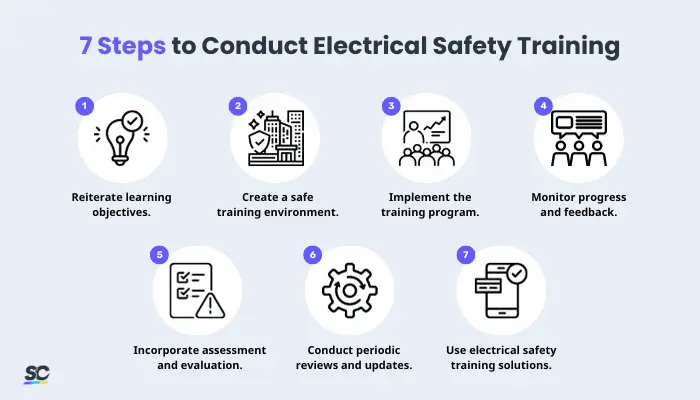What is Electrical Safety Training?
Electrical safety training is a structured program designed to impart knowledge, awareness, skills, and safety practices to various professionals. These include electricians, maintenance personnel, engineers, construction workers, and anyone who works with electrical systems or equipment. Its primary objectives are to ensure worker safety, minimize the risk of electrical accidents, and promote a culture of electrical safety within organizations.
Why Conduct Training For Electrical Safety
According to the US Bureau of Labor Statistics (BLS), there was a 3.75 percent increase in workplace fatalities related to electrocution from 2019 to 2021. Among the top occupations that are commonly exposed to electrical-related workplace incidents are electricians, construction workers, and electrical power installers and repairers.
These are just a few practical examples of how hazardous this type of work can be. Hence, conducting training for electrical safety is an imperative practice for organizations across various industries. Since electrical hazards pose significant risks to employees and the workplace, electrical safety training not only helps protect the safety and well-being of workers but also prevents costly accidents and equipment damage.
Apart from these, consistent training on electrical safety can help in the following aspects:
Prevention of Electrical Accidents
Employees who are well-trained on how to properly and safely execute electrical work have higher chances of preventing electrical accidents. These include electrical shocks, burns, or arc flashes. Such can lead to severe consequences, like injuries, fatalities, and even property damage.
Through training, employees also gain the knowledge and skills they need to proactively identify and mitigate electrical hazards, significantly reducing the likelihood of accidents.
Legal Compliance and Liability Reduction
Regulations and standards, such as those set by the US Occupational Safety and Health Administration (OSHA) and other governing bodies, require organizations to provide electrical safety training to their employees. Failing to comply can result in various legal repercussions, such as fines and penalties. Further, organizations can reduce their liability in case of electrical safety accidents or incidents.
As an overview, here are some OSHA electrical safety training requirements to keep in mind and consider when developing your training program:
- Common Electrical Hazards
- Personal Protective Equipment (PPE)
- Hazardous Locations
- Wiring Methods and Ground-Fault Circuit Interrupter (GFCI)
Fostering a Culture of Safety
When employees understand the importance of electrical safety and actively engage in following safety protocols, it creates a safer work environment for everyone. This culture of safety extends to all aspects of the workplace and helps prevent accidents and incidents beyond electrical hazards.
Key Elements and Topics
Effective training programs encompass key components and content that equip individuals with the knowledge and skills needed to work safely with any electrical task.
Hence, make sure to include these elements so that participants have an in-depth understanding of electrical hazards and the best practices for mitigating them:
- Training Objectives – outline what participants should learn and accomplish during the training
- Target Audience – specific group of participants for certain topics or modules
- Training Methods – formats of how training is delivered based on the content, audience, and available resources
- Training Materials – essential tools for conveying information effectively
- Training Duration and Frequency – training length and schedule to reinforce knowledge and skills building
Also, the following electrical safety training topics must be covered for a holistic program:
- Lockout/Tagout (LOTO) Procedures
- PPE Requirements
- Electrical Equipment Inspection and Maintenance
- Emergency Response Procedures
- Hazard Recognition and Risk Assessment
- Safe Work Practices
- First Aid and Cardiopulmonary Resuscitation (CPR) Training
Guide to Developing a Training Program for Electrical Safety
Creating an electrical safety training program is a structured process that ensures the effective transfer of knowledge and skills to participants. Follow these key steps and considerations before implementing training for electrical safety:
1. Needs Assessment
Through a needs assessment, be able to identify the specific electrical safety training needs of your organization by considering various factors. These include the types of electrical hazards present, the skill levels of employees, and the regulatory requirements applicable to your industry. This type of assessment can help tailor the training content and delivery methods to address specific safety concerns.
2. Curriculum Design
Designing the curriculum involves defining the content, learning objectives, and the sequence of topics covered in the training program. Ensure that it aligns with the needs identified in the assessment phase. Then, develop clear learning objectives that specify what participants should know and be able to do upon completing the training.
3. Trainer Qualifications
Select and assign trainers or instructors who are knowledgeable, experienced, and qualified in electrical safety. They should possess the required expertise to effectively convey information, facilitate hands-on exercises, and answer participants’ questions. Also, they must be familiar with relevant regulations and safety standards.
4. Training Facilities and Equipment
Determine and prepare suitable training facilities equipped with the necessary tools and equipment for hands-on training and simulations. Ensure that these facilities meet safety standards and provide a safe environment for practical exercises.
5. Training Methods and Materials
Choose appropriate training methods and materials based on the curriculum and the needs of the participants. Consider a mix of classroom instruction, hands-on exercises, simulations, and interactive multimedia resources. Develop or acquire these to support the training program.
How to Conduct Electrical Safety Training

7 Steps to Conduct Electrical Safety Training
Implementing electrical safety training is an ongoing commitment to protecting employees and preventing electrical accidents. This is why a well-structured training program must be conducted by following these steps:
1. Reiterate learning objectives.
Based on the planning and development of electrical safety training programs, remember to reinforce and remind employees what’s expected of them after completing the training. Also, ensure that the objectives align with the identified training needs and are measurable, specific, and realistic.
2. Create a safe training environment.
Prioritize the safety of participants by establishing and using training facilities equipped with the necessary tools and equipment for practical exercises. Also, ensure that the training environment strictly adheres to safety standards and guidelines.
3. Implement the training program.
Once everything is prepared and set up, conduct the electrical safety training in a timely and organized manner. Make sure to cover all necessary topics for specific courses or modules that participants will take. This will help ensure the training is holistic and sufficient to address training needs in your organization.
4. Monitor progress and feedback.
Regularly monitor participants’ progress and provide feedback to help them improve their knowledge and skills. Remember to encourage open communication and create a supportive environment for asking questions and seeking clarification on safety-related matters.
5. Incorporate assessment and evaluation.
Don’t forget to evaluate the participants’ comprehension and retention of the training content through various assessment methods. These may include quizzes, practical exercises, and scenario-based evaluations.
Similarly, gauge the effectiveness of the training program through participant feedback and safety performance metrics. This is to continuously improve the program and the objectives being set.
6. Conduct periodic reviews and updates.
Maintain the relevancy of the training program by staying informed about changes in regulations, emerging electrical safety technologies, and evolving best practices. To ensure electrical safety training materials remain current and effective, review and update them regularly or as needed.
7. Use electrical safety training solutions.
Organizations can also strengthen and optimize their processes of implementing training programs for electrical safety with the help of innovative solutions. Whether that may be a platform, mobile app, or dedicated software, trainers and employees can leverage their powerful features and functionalities to complement their training and skill development efforts.
One great example of a tool you can use is the SafetyCulture (formerly iAuditor)’s Training feature. It enables an easy way for leaders, supervisors, and organizations to create, deploy, and track the implementation and effectiveness of electrical safety training with the help of Training’s key capabilities and more:
- Pre-made training course templates
- Analytics and reporting
- Training records
- Course certificates
- Custom achievements
- Admin suite
- Notifications
Apart from that, you can also use the holistic SafetyCulture platform to create checklists and templates that you can use in standardizing evaluation processes and how training for electrical safety is conducted.
Create Your Own Electrical Safety Training Checklist
Eliminate manual tasks and streamline your operations.
Get started for FREE



